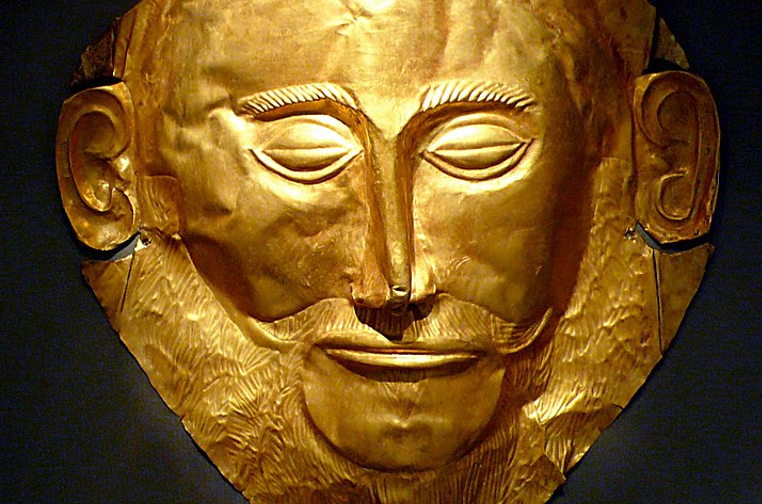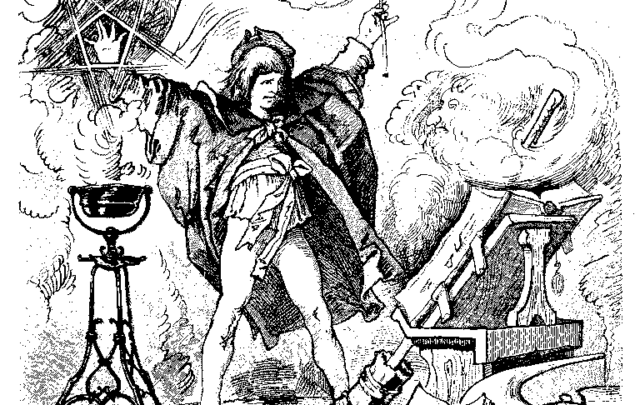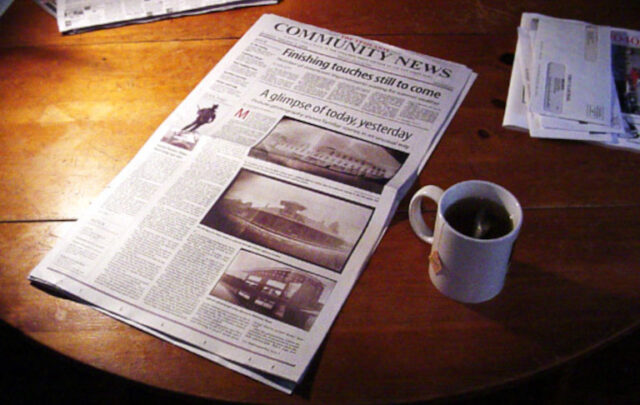Much of our thinking and imagination today derives from Hollywood. The post-apocalypse genre is so pervasive that it is commonplace to hear people describe the coronavirus outbreak as the ‘beginning of a movie’, that moment in the first hour of a film where the minor signs of something wrong quickly escalate into disaster. The threat, whether from zombies, asteroids, pandemics, war, aliens or anything else rapidly overwhelms the calm gentle world of our protagonists. Not long after everything ceases: law and order, commerce, basic public protection, all forms of governance. This straight quick line from disaster to collapse happens simply, quickly and coherently.
However, the collapse of ordered societies doesn’t happen in such a manner. The reality of collapse is that a series of small, unrelated actions impact on systems of diplomacy, economics and power with disproportionate and unpredictable results. Consider the murder of Archduke Franz Ferdinand by Serbian nationalist Gavrillo Princip in 1914. Such an action could not have been foreseen to initiate the collapse of multiple European empires, the fiscal ruin of the British state, a Bolshevik coup and the map of the Middle East being redrawn. Historians still have no consensus over the exact causes of WW1, despite oceans of ink being spilled on the subject. This is because systems of such overwhelming complexity don’t respond to events in predictable linear ways, but rather by lurching and with shuddering jolts. The impact of events can often be felt only after many generations.
This irreducible complexity explains why events such as the disintegration of the Western Roman Empire, the collapse of the civilisations of the Chaco and the Maya, the Protestant Reformation and the French Revolution are unpredictable beforehand and difficult to explain afterwards. The collapse of the Western Roman Empire has had varying explanations put forward including: the seditious nature of Christianity, barbarian invasions, cultural decadence, economic decay, a top heavy bureaucracy and an unstable system of governance to name but a few. Taken together it becomes impossible to point to one event that led to the disintegration of the Empire. We should also be wary of ascribing purely negative connotations to the collapse of an empire. In James C Scott’s book Against the Grain he describes how the regular collapse of the early Mesopotamian states led to increase in life expectancy among the scattered populations. Densely packed livestock and humans together with a highly stratified society on a monotonous grain based diet often led to pandemics, famines, war and rebellion.
As the world currently battles the outbreak of COVID-19 it certainly feels like we are witnessing a major historical event, one that could possibly lead to the collapse or fragmentation of the USA or the European Union. But when major systemic events like this occur, are they singular in nature or do they combine with existing forces? If so, is it possible to analyse these trends as they are occuring? One of the best prehistoric case studies is the ‘Bronze Age Collapse’ which occured in the decades of approximately 1150 BC. A great series of natural disasters, wars, invasions and city abandonments occurred across the Aegean and Mediterranean seas which led to the unravelling of trade routes, diplomacy and economies. The resulting ‘Dark Ages’ eventually gave rise to the Greek city-states for whom the invasion of Troy and the journeys of Odysseus were already legendary. The collapse ended the use of Linear B as an alphabet and destroyed the fragile trading networks which allowed empires to blend rare tin and copper to form bronze. The city-states which emerged from the Dark Ages relied on local iron rather than bronze, ushering in a new era and providing Greek philosophers with a mythical past to claim as a Golden Age.
In order to make sense of such a distant world it is necessary to set the context. The late Bronze Age was the first time that the world truly became globalised in any real sense. The biblical kingdoms of Anatolia, Mycenae, Babylonia, Egypt, Canaan, Assyria and Mesopotamia rose across the Mediterranean and became interconnected in hitherto unimaginable ways. The period between 4000-1100 BC saw the development of city states and empires such as the Akkadian (23314-2154 BC), the late Uruk (3400-3200 BC), the Old Kingdom of Egypt (2686-2181 BC) and the Mycenaean period of Greece (1600-1100 BC). An explosion of creativity produced advanced metalworking, cuneiform script, modern mathematics, the invention of credit, a bureaucratic class, long-distance trade, coastal shipping routes, international diplomacy and large-scale monumental architecture. Akkadian became the lingua franca for diplomatic communication, as attested to by the astonishing Amarna Letters, a series of cuneiform tablets which reveal the extent of contact between rulers. These include pleas of military assistance, fragments of poetry and the arrangement of marriages. In part, these far reaching trade and diplomacy routes were about securing vital natural resources for the different States. Bronze in particular suffered from the need to obtain both copper and tin, unlike iron, which made it more vulnerable to the loss of a secure source. To quote academic Carol Bell ,
“the strategic importance of tin in the LBA [Late Bronze Age] . . . was probably not far different from that of crude oil today.. The availability of enough tin to produce . . . weapons grade bronze must have exercised the minds of the Great King in Hattusa and the Pharaoh in Thebes in the same way that supplying gasoline to the American SUV driver at reasonable cost preoccupies an American President today!”.
Despite the connectivity and advancements of this militarily and politically powerful world, the evidence points to a widespread period of war, famine and natural catastrophes. Beginning around 1200 BC, a vast number of important cities appear to have been destroyed, in a wave of devastation stretching from Greece to Anatolia, to Syria and Egypt. The list includes Troy, Knossos, Ashdod, Kadesh and Ugarit, succumbing to a combination of rebellions, fire, earthquakes and invasions. A number of contemporary sources mention the appearance of the mysterious ‘Sea Peoples’, who have become legendary in any discussion of the collapse. The inscriptions of Ramses III in 1177 BC refer to a number of invasions from the sea, people sporting feather headdresses, skull caps and horns. In all likelihood these attacks were uncoordinated assaults from numerous peoples fleeing parts of the northern Mediterranean, nevertheless they have gone down in history as a singular people, responsible for a tidal wave of destruction. Alongside the loss of major cities came the collapse of trade, letters imploring more powerful rulers to send grain to alleviate famine and the death of centralised palace command centres, such as at Knossos on Crete. The shockwaves of these losses, of drought, earthquakes, war and trade disruption caused a total collapse to the international order which had dominated for over 300 years.
The suddenness of this collapse can be seen in the innocence of the letters still being sent from Ugarit to Cyprus and the Hittites and praising the Pharaoh for lavishing the king with gifts. Ugarit was to be destroyed soon afterwards, but one would never know from these communications. In some places entirely new cultures appeared over the ruins of the old, and in others there was to be such severe depopulation that it took over a millennium to recover. Of the major empires which dominated the region, only Egypt had the resilience and depth of resources to survive. All the others vanished. By 1000 BC the international order had been replaced by smaller, more local city-states. Palaces, centralised administrations, bureaucratic hierarchies and even alphabets and the concept of writing itself vanished in large areas. The oral cultures which replaced it were, in time, to give rise to the epic poetry of The Iliad and The Odyssey. The new civilisations and peoples which were born from the ashes of the old, the Phoenicians, the Israelites, the Neo-Assyrians and Hittites, the Athenians and Spartans, created the world in which we now live. We have inherited their legacies, their alphabets, politics and religions.
What lessons can we learn then from this event? It seems unlikely that we will see the collapse of centralised administrations and bureaucracies as a result of coronavirus, if anything we may see a strengthening. We’re also unlikely to see any major loss of the fundamentals of civilisation: literacy, writing, diplomacy and technology. Companies which provide digital technology are also likely to be strengthened by coronavirus. In which case, are there any parallels at all between the two worlds?
Firstly we can point to the interconnectedness, or what Eric Cline calls ‘hypercoherence’, as a major factor in the nature of the collapse. British archaeologist Susan Sherratt calls the Bronze Age, “an increasingly homogeneous yet uncontrollable global economy and culture… where political uncertainties on one side of the world can drastically affect the economies of regions thousands of miles away”. This is strikingly similar to our own hyper-globalised world which has shown its vulnerability of economies to financial crises and now human vulnerability to novel pathogens. An increase in dependency creates an increase in fragility. A lesson we may want to learn is how to decrease our fragility.
The second lesson that the Bronze Age Collapse teaches us what happens when economies do become disconnected by force. The Greek term autarkia, or autarky, means self-rule and self-sufficiency and became a term of significance in the decades following the collapse. As the centralised command economies of the empires vanished there was a rise in local self-sufficient city states. The loss of alloy materials to make bronze led communities to fall back on iron, which, counter to common belief, is inferior in many ways to bronze, not least that bronze does not rust. The cheaper, more local, yet inferior technology increased markedly after the collapse and allowed smaller city-states to arm and tool themselves without relying on long distance trade for copper and especially tin. This fragmentation is the natural pattern of a system which cannot be sustained and collapses into smaller components. As mentioned above, Scott, and other academics don’t see this as necessarily a bad thing. Populations freed from the tyranny of empire often show an increase in health and life expectancy. The re-centering of our economies around more local and less distant trade routes should be a lesson we learn and apply quickly.
A third and final lesson which we should absorb is the understanding that collapses do not happen in a predictable linear sequence. Although by historical standards the collapse of the Bronze Age order happened very fast, for someone living through it events would have happened over decades. The decline of trade, diplomacy and the reach of power can happen slowly at first and then suddenly with remarkable speed. Phenomena like climate change are what military strategists call ‘force intensifiers’, things that a strong state could manage if alone, but combined with acute events serve to intensify the action. For example, a drought causing a famine could have been dealt with by any of the major Bronze Age empires, but combined with an earthquake on crucial coastal cities, internal rebellion and external invasion quickly overwhelm the capacity of the state to act. Likewise today, we are in a position where the virus can be managed by most states, but we have yet to see how it combines with conflict, climate change, high levels of public and private debt and the epidemic of obesity and diabetes. The crash of 2008 may well have been a precursor to a more general economic disaster. We simply do not know. What we can do is study and learn from history. What are the conditions that lead to a systemic collapse? How do we mitigate against them? And, what tradeoff between connectivity and fragility are we willing to tolerate?
Sources and background reading
Cline, E.H., 2015. 1177 BC: The year civilization collapsed. Princeton University Press.
Bell, C., 2012. The merchants of Ugarit: oligarchs of the Late Bronze Age trade in metals. Eastern Mediterranean Metallurgy and Metalwork in the Second Millennium BC, Oxbow Books, Oxford, pp.180-187.
Scott, J.C., 2017. Against the grain: a deep history of the earliest states. Yale University Press.
Drake, B.L., 2012. The influence of climatic change on the Late Bronze Age Collapse and the Greek Dark Ages. Journal of Archaeological Science, 39(6), pp.1862-1870.
Knapp, A.B. and Manning, S.W., 2016. Crisis in context: The end of the Late Bronze Age in the eastern Mediterranean. American Journal of Archaeology, 120(1), pp.99-149.
Teaser photo credit: By Xuan Che – Self-photographed (Flickr), 20 December 2010, CC BY 2.0





